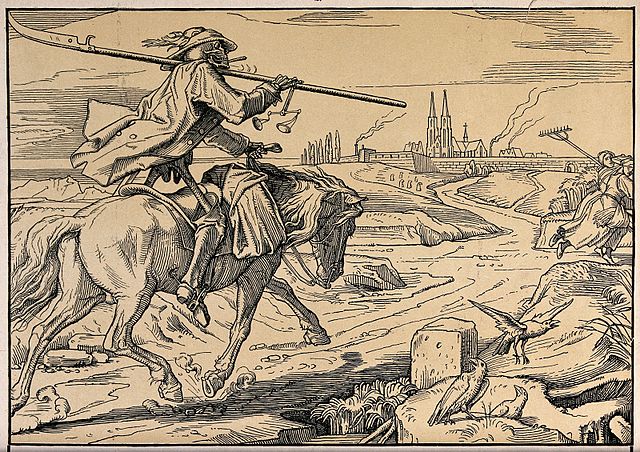The Star Plague
The gods! The gods! There are cities that even the carrion crow dares not overfly, and you would talk to me of the will of the gods? The death of a world lays at their feet! May the plague strike down the gods, and if any remain may they meet my sword!The star plague is a contagious, highly deadly disease likely of natural origin and cause. It is so named because sufferers of the most common strain feel a tremendous heat in their bodies, which has been described like a star ignited in their breast. The three strains are named for where in the body they strike - pneumatic (meaning occurring in the lungs), lymphatic (occurring in the lymph nodes), and septicemic (occurring systemically in the blood), though historically they have had a variety of different names. It is only recently that science has confirmed the three strains to be caused by the same bacterium. The lymphatic strain is by far the most common. The star plague has reoccured for thousands of years, presenting a constant threat to civilization, albeit mostly in its native climes of the steppes of the continent Remik. The Great Plague was the worst of the star plagues to strike Veshiri in recorded history, wiping out somewhere between a fourth and three fifths of the world's population over the course of a hundred years - the exact percent is debated, due to irregular record keeping and few censuses. The Great Plague caused social, religious, and economic upheavals when it hit, permanently changing the course of history.
Transmission & Vectors
Each of the three strains of the Star Plague is transmitted differently. The pneumonic strain is airborne, being transmitted through infected droplets of sputum, though fortunately doesn't live long outside the body, and frequently has trouble spreading outside of cramped city tenements. The lymphatic strain is most commonly transmitted through the bites of infected fleas (which can be elven or animal fleas) and rarely infected rodents, though can also rarely be transmitted by contact with infected bodily tissue. The septicemic strain is the hardest to transmit, relying entirely on contact with infected tissues or bodily fluids, or occurring as a secondary infection after the disease spreads from its original incubation site to the rest of the body.
Symptoms
The first symptom is often a fever and a headache, which can last for a few days or rapidly progress into more specific symptoms.
Lymphatic Plague
Lymphatic plague's first non-general symptom is vomiting, then non-localized muscle aches, followed by a tremendous swelling of the lymph nodes, especially in the neck, groin, and armpits. Rarely, the swollen nodes may break open, leaking highly infectious fluid. Gangrene can occur in the fingers, toes, lips, and nose. Lymphatic plague almost always results in the characteristic star-feeling, which is likely a hallucination or a side effect of the high fever. Death usually occurs within ten days of the lymph nodes beginning to noticeably swell.Pneumatic Plague
The pneumatic strain has a short incubation period, progressing to disease often within days of initial infection, though incubation periods of mere hours have been reported. It brings with it coughing, chest pain, and dyspnea (difficulty breathing) at first, which progresses rapidly to chills, coughing of blood, and a perception of tremendous heat. Death follows the full symptoms within one to six days.Septicemic Plague
Septicemic plague is when the bacterium infects the bloodstream or the full system, causing sepsis and systemic shock. It is most commonly a secondary infection, following after lymphatic or rarely pneumatic plague, but can occur on its own. The toxins released by the bacterium frequently cause disseminated intravascular coagulation (DIC), or a clotting of blood that blocks small blood vessels. The blocked-off tissues frequently die, becoming necrotic. The body stops being able to close wounds, worsening bleeding, and as DIC progresses internal bleeding may occur, resulting in blood in the stool, urine, and lungs, and red or black patches under the skin. Septicemic plague can cross the blood-brain barrier in rare occasions, resulting in hallucinations, confusion, erratic behavior, difficulty speaking, and difficulty coordinating limbs, and the high fever it brings often further worsens neurological symptoms. However, the neurological symptoms frequently appear before the blood begins to clot, meaning that those taken to temples and hospitals for treatment of strange behavior have a higher rate of survival than most of those infected. The most horrifying symptom of the septicemic plague is the complete breakdown of internal organs shortly before death, with blood vessels shattering and organs hemorrhaging into the body's cavities. Blood and pus begin to seep out of every orifice as the body loses its shape, creating a tremendous risk of further infection for any who come into contact with the body.Treatment
There is no known non-magical treatment for the star plague. Powerful healing magic can cure sufferers, but such magic is often not available in the amounts needed to treat a city in the throws of an outbreak, let alone an entire region.
Prognosis
The prognosis once the disease has progressed past a mild fever is grim, and varies with strain. The lymphatic plague is the least deadly, with an untreated death rate of fifty percent, while the pneumatic and septicemic plagues both have a death rate of nearly one hundred percent. Death for the pneumatic version takes up to six days from when full symptoms appear, while the septicemic version often results in death the same day as conclusive symptoms.
Sequela
Septicemic plague frequently results in organ failure, even if the patient is treated with healing magic, resulting in life-long problems unless more powerful magic is brought to the table. Lymphatic plague can cause a lingering weakness and muscle ache, while pneumatic plague tends to cause problems with the lungs.
Affected Groups
The plague is noted for not discriminating, striking at rich and poor alike with equal ferocity. Those who work with animal carcasses or are at high risk of flea bites are more likely to be the first patients in an outbreak, but once the disease picks up momentum none are truly safe.
Luckily, the plague has yet to jump world barriers, and immigrants and visitors from other planets are immune - resulting in a sort of herd immunity in cities like Sistu with large immigrant populations.
Hosts & Carriers
Fleas are the most notorious hosts of the plague, which causes blockages in their stomach, driving them to ever greater hunger until they finally starve to death. Few Veshiri animals are passed over.
Prevention
The only prevention is to avoid contact with fleas and potentially infected tissue - or to not travel to affected areas at all. Scrupulous cleanliness can discourage the disease, but often only over a population - if everyone around you is flea-ridden, your own washing habits hardly matter.
Epidemiology
The disease spreads most rapidly in cramped tenements, as the airborne pneumatic plague and the fleas that carry the lymphatic plague both thrive when people are packed closely together.
History
The true origin of the star plague is unknown, but given Veshiri's low magic and lack of contact with other worlds, a natural origin is currently the most widely supported theory. However, many currently - and most throughout history - have attributed the plague to the anger of the gods.
The Great Plague, the first well-documented outbreak, and the most deadly, was first reported in 1,711 of the Dawn Era, starting in rural communities where plague had long been endemic and quickly sweeping into larger cities. It came to the Kodiri Empire a mere two years after the initial outbreak, where it was slowed in part by the Kodiri's love of cats and bumble dragons large enough to hunt vermin, resulting in unusually low rat populations. Additionally, cleanliness rituals resulted in fewer places for fleas to harbor, there was a taboo against handling carcasses with bare hands, and the cities were often notably less cramped than most of their counterparts.
Still, the plague spread on, by ship and land, arcing through Kodiri and through the continents around it. The plague came late to Lokmei, taking an entire seven years to cross the mountains, where it proceeded to rip through the largely urban population, resulting in some of the highest casualties recorded in the world. Lokmei's ruling dynasty crumbled, and it would be over a thousand years before another rose to take its place.
Notably, in 1659 of the Dawn Era, the plague struck down the King Emperor of the Kodiri Empire and his immediate family, despite their new habit of seclusion, wearing heavy clothes and refusing to even enter the same room as outsiders. Few from the royal family remained, except Hiwumoko, a minor noble in a remote mountain town too cold for fleas.
Outbreaks continue into the modern day, though after Veshiri joined the Council of Worlds 3,507 years ago, the interplanetary community began to make concerted efforts to aid in relief during the worst outbreaks. Volunteer organizations, consisting primarily of those trained in healing-focused magical traditions, have developed a rapid response system for when the first signs of outbreak are spotted. While initially formed to combat diseases common to the founding worlds, such organizations now operate throughout the Council, with natives of the planet Alea forming a noticeable contingent.
The government of Veshiri has made the discovery of a non-magical means of combating both the Star Plague and other diseases a top priority, paying chemists, biologists, and doctors to research the dangerous bacterium responsible for the disease. There has been some hope for finding a vaccine ever since vaccines were discovered a century ago, mostly by analyzing the blood of those lucky few who recovered on their own.
Cultural Reception
Persecution of minorities spiked, with the disease frequently blamed on godlessness - and therefore on the heretics, unbelievers, heathens, and others found to be insufficiently pious. Minority communities were frequently driven out of cities and even nations entirely - widening the spread of the disease, and doing nothing to protect the supposedly righteous from the killer already in their midst. Indeed, many of those driven out held specialized professions, often ones necessary for the health of a society in the midst of an pandemic.
Lokmei blamed the plague on the Meqausho, their untouchable caste, as well as on lepers and others with skin diseases, leading to several massacres and an introduction of laws restricting the free movement of stigmatized castes.
Impacts
Social and Economic
The indiscriminate deaths causes tremendous social upheaval. Suddenly, there weren't enough people in the high rungs of society, nor were there enough laborers and artisans. Wages soared and working conditions improved, as laborers and skilled artisans found they were in high enough demand to have their choice of where to work. Class mobility increased, and areas with caste systems found those systems either collapsing or, in the case of Lokmei, becoming unstable long-term despite the ruling caste's determination to hold onto power. Revolutions and civil wars swept across the globe, with dynasties either toppling or making tremendous concessions left and right. The Kodiri Empire began to fracture after the death of the King Emperor and his family, leading to one of the largest civil wars in history, until Queen Empress Hiwumoko's death. Her daughter, Queen Maiqa, refused to continue the war, and made peace with the new states that had formed out of the old empire. Veshir I was among those to lose family to the plague, and was one of the many warlords who sprang up in the slowly fracturing Kodiri Empire as rule of law broke down and local people took their fate into their own hands. He established a small state, and would later wage war on the now small Kodiri Nation, sacking the Golden Palace, slaying Queen Maiqa and all her retainers, and founding the Veshiri Empire, which would go on (under the rule of his descendants) to unite the planet under a single banner for the first time in history.Art and Architecture
Death became a common theme in art, literature, and architecture after the Great Plague. Skeletons were illustrated participating in everyday scenes, or leading the unsuspecting to their deaths. Rulers were shown with Death behind their shoulder, or cities with a grim specter looming over them. Books, tales, poems, and plays displayed a fixation on questions of mortality and the moral nature of the gods.Religious
When the Great Plague first came, many asked the gods why. Why this? Why now? Why them? Most found their answer in scapegoats, deciding that the ill had clearly angered the gods somehow - or that the well had clearly poisoned them. But some reacted differently. The Great Plague marked the crystallization of dystheism, the belief that the gods are not good and might be malicious. The Order of the Serpent, led by the Lokmei paladin Kahbe Ghavani, who had witnessed multiple outbreaks in his long service as a healer, declared that the gods were apathetic to the plight of elves and could not be relied upon. Instead, elves must have faith in themselves and their communities, and must build a better world through their own labor. The Order of the Serpent spread rapidly - the idea that the gods had forsaken them resonated with the populace. But one woman, Sabi Jobai, who had as a child been the sole survivor of an outbreak that wiped out her village, found that the condemnation of the gods as merely apathetic was not far enough. After all, is it not a tenant of the paladin that to stand by while evil occurs is itself an evil act? Did not the gods make the world, and therefore the plague itself? Did not the supposedly good gods do nothing to stop their malevolent peers? She declared that the gods were actively evil, and that it was the duty of all who swore themselves to the path of righteousness to remove them from the world. She formed the Order of the Black Rose, which, along with encouraging people to build communities free of religious influence, sought to train until they could present a threat to the very gods who had stood idly by. Sabi became the most powerful Veshiri spellcaster in recorded history, her righteous fury propelling her to ever greater heights, until her Roses attracted the attention of one of the major gods of her homeland, the rain god Imgah, who was angered that the Serpents and the Roses had brought people away from his worship. She struck him down after a mighty battle, giving her life to free her people from his frequently temperamental influence. The belief in the supremacy of the gods was shattered, and no new god rose to take his place.
Type
Bacterial
Origin
Natural
Cycle
Short-term
Rarity
Uncommon






Starting off with some blasphemy, love it. I like that this plague has led to some questioning the gods, I think thats a decent response to be fair.